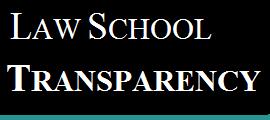- You are here:
- Home »
- Changing Legal Landscape »
- Problems persist with law school jobs data, watchdog says
Problems persist with law school jobs data, watchdog says
5 March 2013 – The American Bar Association now requires law schools to be more upfront about how their graduates perform on the job market, but problems with misleading or incomplete employment data persist, according to a watchdog group.
The nonprofit Law School Transparency, formed in 2009 by two then-Vanderbilt law students, examined postgraduate employment data posted on the websites of all 199 ABA-accredited law schools. It concluded that close to half haven’t met the expectations set by Standard 509, the ABA’s tougher reporting requirements.
Law School Transparency stopped short of accusing those schools of violating the standard, saying it’s not in a position to make that determination.
“There has been much ado about the improved accreditation standards, but the improvements are meaningless without compliance and enforcement,” the organization wrote.
It claimed that the ABA has taken no enforcement measures beyond emailing law schools to remind them of the new reporting requirements. Barry Currier, the ABA’s interim consultant on legal education, disputed that assertion. The Section of Legal Education and Admissions to the Bar has had behind-the-scenes contact with law schools regarding compliance with Standard 509, and will continue to request information from schools that may not be meeting the requirements, he said.
“One cannot assume, by the absence of public information, that nothing is going on,” Currier said. He noted that any ABA probe of a law school must remain confidential unless the school chooses to disclose it.
The ABA conducts full accreditation reviews every seven years, but questions about schools’ compliance with its long list of standards can and have been addressed in the interim in some cases, Currier said.
Still, the ABA will examine Law School Transparency’s report to see if it merits action, as it has done with other independent reports of potential Standard 509 compliance problems, he said. The ABA hopes to create a process by which it could review or audit the employment information provided by law schools.
“We’ve stepped up to plate in terms of adding to the reporting requirements, and we are gearing up our enforcement efforts,” Currier said.
The ABA began collecting the more comprehensive jobs data after a series of questionnaire and accreditation standards changes in 2011 and 2012. Law schools now are required to provide two charts of data. One pertains to graduate employment outcomes; the other to conditional scholarships and the percentage of students who retain those grants throughout their time in law school.
Law School Transparency first looked at whether law schools had posted both charts on their websites, as required by Standard 509, and whether it was complete, accurate or misleading. The organization also examined whether law schools went beyond the ABA reporting requirements by releasing the annual hiring report generated by NALP (formerly the National Association of Law Placement) for its graduates. The organization compiled those findings into what it has dubbed the “Transparency Index.” The index rates each individual school on the completeness and accuracy of its jobs data.
Initially, Law School Transparency found that 78 percent of law schools had not met the expectations of Standard 509. More than half—65 percent—had failed to post one or both of the required charts, and 46 percent reported data that Law School Transparency judged misleading, incomplete or inaccurate. The most common problem involved the reporting of graduate salaries—many schools failed to declare the percentage of graduates upon which their salary figures were based, the organization said.
The group informed law school administrators in early February of its findings. In the following three weeks, 84 law schools replied that they had updated their employment data in some way. By the end of the month, the percentage of schools with Standard 509 problems had fallen to 49 percent, and the percentage that had not published one of both of the required charts had fallen to 35 percent.
Additionally, sixty-four percent of the law schools now provide some type of jobs information that goes beyond what the ABA requires, the group said, and 44 percent have made their NALP hiring report available to the public.
Nearly a quarter of the schools earned a perfect score—meaning that Law School Transparency found no problems with their ABA-mandated jobs data and that they had voluntarily provided additional data in 10 specific areas.
“Our hope is that when law schools claim to be transparent and claim to value being open and honest with prospective students, the Transparency Index will provide a check on those claims,” the report reads. “It will be easier to understand what exactly the schools are doing (or not doing) with their graduates’ employment information, and it will allow people to compare school disclosure policies and wonder why certain schools choose to selectively conceal the information they have.”

